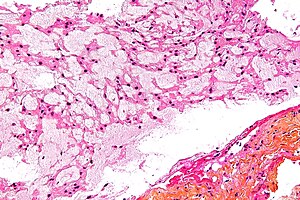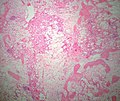Chordoma
Jump to navigation
Jump to search
| Chordoma | |
|---|---|
| Diagnosis in short | |
 Chordoma. HPS stain. | |
|
| |
| LM | physaliphorous cells (also bubble cells) - very large clear bubble with a sharp border, bubble does not compress nucleus; islands of cells surrounded by fibrous tissue; myxoid background |
| LM DDx | chondrosarcoma, myxoid lesions, parachordoma, chordoid lesions (e.g. chordoid glioma, chordoid meningioma), metastasis (e.g. clear cell renal cell carcinoma) |
| IHC | S-100 +ve, AE1/AE3 +ve, Brachyury +ve, EMA +ve |
| Gross | myxoid |
| Site | sacrum or clivus |
|
| |
| Prevalence | uncommon |
Chordoma is an uncommon tumour in neuropathology.
General
- Location: usually sacrum or clivus.
- It is a malignant bone tumour (1-4% of all primary bone tumors).
- Usually after age 30.
- Comes in three flavours:
- Chordoma, NOS (ICD-O: 9370/3)
- Chondroid chordoma (ICD-O: 9371/3)
- Dedifferentiated chordoma (ICD-O: 9372/3)
Gross
- Soft, gelatinous, lobulated.[1]
DDx:
- Bony metastasis (mucinous carcinoma) - typically multifocal.
Image:
Microscopic
Features:[2]
- Architecture: islands of cells surrounded by fibrous tissue.
- Also described as "lobulated" architecture; may not be apparent.
- Myxoid background - grey extracellular material, variable amount present.
- Mixed cell population:
- Abundant eosinophilic cytoplasm.
- Physaliphorous cells or bubble cells - key feature.
- Have a very large clear bubble with a sharp border; bubble does not compress nucleus - nucleus may be in bubble.
DDx:
- Chondrosarcoma - negative for EMA and cytokeratins. Beware of 'chondroid' chordoma.
- Myxoid lesions.
- Myxopapillary ependymoma.
- Myxoid liposarcoma - negative for EMA and cytokeratins.
- Chordoid lesions.
- Chordoid meningioma.
- Chordoid glioma[3] - location, location, location.
- Large notochordal rest - only evidence of destructive growth can identify a chordoma.
- Metastasis.
- Metastatic signet ring cell carcinoma - negative for S100 and brachyury, clinical history (important).
- Metastatic clear cell renal cell carcinoma - negative for S100 and brachyury, clinical history (important).
- Parachordoma - extremely rare.
Images
www:
- Chordoma (upmc.edu).
- Chordoma - sacrum - several images (upmc.edu).
- Chordoma - additional case with several images (upmc.edu).
IHC
- S-100 +ve.
- AE1/AE3 +ve.
- Brachyury +ve -- key stain.
- EMA +ve.
- Other keratins:[8]
- CK8 +ve (16/16).
- CK19 +ve (16/16).
- CK18 +ve/-ve (9 +ve/16).
- CK7 -ve (1 +ve/16).
- CK20 -ve (0 +ve/16).
Key points:
- Brachyury is not a commonly stocked antibody.
- Chordoma will be S100 AND Epithelial marker positive.
- Many other items in the DDX will be either S100 OR Epithelial marker positive.
See also
References
- ↑ URL: http://www.histopathology-india.net/Chordoma.htm. Accessed on: 12 April 2012.
- ↑ Tadrous, Paul.J. Diagnostic Criteria Handbook in Histopathology: A Surgical Pathology Vade Mecum (1st ed.). Wiley. pp. 184. ISBN 978-0470519035.
- ↑ Zarghouni, M.; Vandergriff, C.; Layton, KF.; McGowan, JB.; Coimbra, C.; Bhakti, A.; Opatowsky, MJ. (Jul 2012). "Chordoid glioma of the third ventricle.". Proc (Bayl Univ Med Cent) 25 (3): 285-6. PMID 22754136.
- ↑ URL: http://path.upmc.edu/cases/case312/micro.html. Accessed on: 14 January 2012.
- ↑ Coindre, JM.; Rivel, J.; Trojani, M.; De Mascarel, I.; De Mascarel, A. (Sep 1986). "Immunohistological study in chordomas.". J Pathol 150 (1): 61-3. doi:10.1002/path.1711500110. PMID 2431128.
- ↑ Online 'Mendelian Inheritance in Man' (OMIM) 601397
- ↑ URL: http://www.jstor.org/pss/86845. Accessed on: 18 May 2010.
- ↑ Naka, T.; Iwamoto, Y.; Shinohara, N.; Chuman, H.; Fukui, M.; Tsuneyoshi, M. (Jun 1997). "Cytokeratin subtyping in chordomas and the fetal notochord: an immunohistochemical analysis of aberrant expression.". Mod Pathol 10 (6): 545-51. PMID 9195570.









